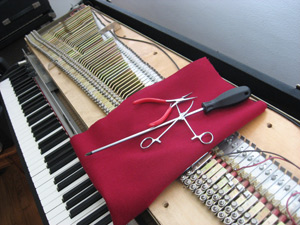Fender Rhodes Piano Voicing
Voicing is the process of adjusting each note’s level and tonal qualities. There are several factors that influence the voicing of Fender Rhodes pianos: the hammer tip hardness, the position of each tine and pickup, and the magnetic field around the pickup.

The Tools
[1] Reference Monitors [2] Spectrum Analyzer [3] Piano TunerReference Monitors
Reference monitors are essential to hearing the full range of frequencies the Rhodes piano generates.
Voicing Methods
There are different ways to voice a Rhodes piano. It can be set to factory specs, brighter, darker, or customized to personal taste (for example, modified lower octave for super low bass). Since 1994 we have optimized the voicing process by using a combination of analog and digital tools. These tools help us achieve perfect voicing according to our client’s requirements, and maintain consistency.

Spectrum Analyzer
The Human Factor
Voicing a Fender Rhodes piano is considered an art as well as a science. A good Rhodes voicing technician needs to be able to play the piano, be proficient in identifying audio frequencies, and have a thorough understanding of the mechanical and electrical systems in the piano, in order to identify abnormal voicing issues.
A known psycho-acoustic challenge in voicing Rhodes pianos is the fact a human ear gets tired quickly when listening to repetitive sounds. Digital tools like the Spectrum Analyzer help ensure the accuracy of sound pressure levels as well as correct harmonic relationships between the fundamentals and harmonics for each note. Working with a spectrum analyzer helps us minimize errors and achieve optimal voicing, even when we need to meet challenging deadlines.